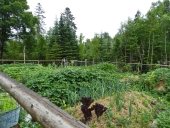Newcomers here, and this is our story. Any advice will be appreciated.
We've had lots of changes around our house in rural VA in recent years. Starting with hurricane Isabel, a series of storms have taken down quite a lot of poplar and pine trees--many of the pines being infested with beetles. Predators have reduced our flock of free-range chickens to the point that we decided it's best to only keep a few to produce eggs for our own use. Falling trees damaged outbuildings and threatened the house, so we sadly decided to remove trees that might hit the house if they fell. What that has left us with seems to be a bunch of opportunities, and we are working toward realizing those.
We have had a small garden for awhile, using marginally-raised beds, and that has provided us with some vegetables ... but did more for our overly-free-ranging hens. Our new strategy is going to be to confine them within the fenced-in area where our goats live, placing a smaller hen house in there (the old one is coming down, but the ground it sits on is very rich!). The goats and hens get along, and maybe the goats will help keep the nocturnal feeders away. Time will tell. I'm personally just tired of go-wherever-they-like chickens having so much control over my home and life. They'll be more confined and not free to go wherever they wish, but I'll be able to grow things where I want, and keep the porches clean. The hens will still have plenty of space to wander around in the sunshine, and several of them already spend most of their day hanging out with the goats.
But I digress ... here's where feedback could be really useful!
What used to be our front yard, devoid of grass thanks to the chickens scratching it all up, is going to become a series of hugelkultur mounds. At present, we're thinking of only making them about a meter high and 4-6 feet wide (length will vary according to location). Because we have a lot of pine that has been down for a few years, and is at the stage that it's really sponged up water but hasn't started to crumble entirely, I am splitting that stuff up and laying it tightly as the base strata for our mounds. I've seen all sorts of varying comments about using pine/not using pine, but I thought that I'd go with what I have, and I've got tons of that. If nothing else, it ought to hold moisture at the core of the mounds.
On top of that, I plan to stack a layer or two of split poplar logs. These aren't as decomposed as the pine. In fact, they have only been cut for a few months, but the average of all the wisdom that I have seen seems to suggest that using them as a barrier above the pines might be a good plan. Over that I will put a good bit of mixed wood-chip mulch (from the branches of the trees that came down), then some rotting straw and leaves on top of that, and finally a good layer of soil that will be heavily mixed with composted chicken manure. That's about the best plan I can think of, using the materials that we currently have on hand.
We are in the process of building our first mound now, and hope to plant it soon. Any suggestions for veggies that might do well as a first-season crop for this particular combination? Am I planning anything that has glaring problems that I'm too inexperienced to see right now?




